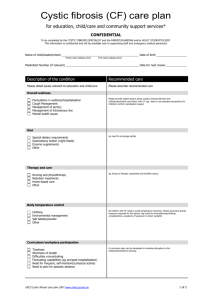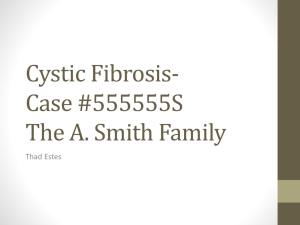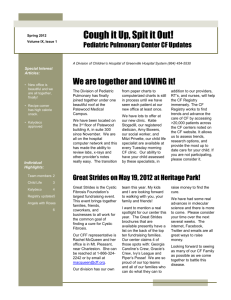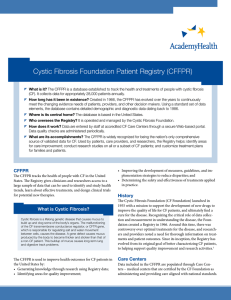Cystic Fibrosis Foundation Patient Registry
advertisement
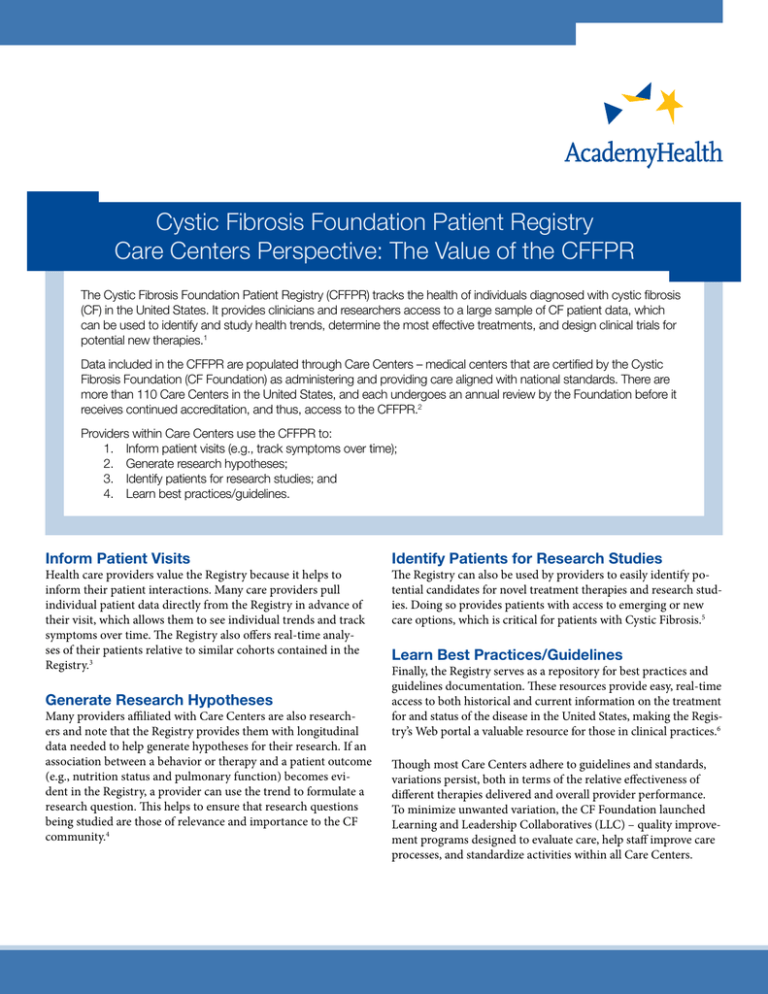
Cystic Fibrosis Foundation Patient Registry Care Centers Perspective: The Value of the CFFPR The Cystic Fibrosis Foundation Patient Registry (CFFPR) tracks the health of individuals diagnosed with cystic fibrosis (CF) in the United States. It provides clinicians and researchers access to a large sample of CF patient data, which can be used to identify and study health trends, determine the most effective treatments, and design clinical trials for potential new therapies.1 Data included in the CFFPR are populated through Care Centers – medical centers that are certified by the Cystic Fibrosis Foundation (CF Foundation) as administering and providing care aligned with national standards. There are more than 110 Care Centers in the United States, and each undergoes an annual review by the Foundation before it receives continued accreditation, and thus, access to the CFFPR.2 Providers within Care Centers use the CFFPR to: 1. Inform patient visits (e.g., track symptoms over time); 2. Generate research hypotheses; 3. Identify patients for research studies; and 4. Learn best practices/guidelines. Inform Patient Visits Health care providers value the Registry because it helps to inform their patient interactions. Many care providers pull individual patient data directly from the Registry in advance of their visit, which allows them to see individual trends and track symptoms over time. The Registry also offers real-time analyses of their patients relative to similar cohorts contained in the Registry.3 Generate Research Hypotheses Many providers affiliated with Care Centers are also researchers and note that the Registry provides them with longitudinal data needed to help generate hypotheses for their research. If an association between a behavior or therapy and a patient outcome (e.g., nutrition status and pulmonary function) becomes evident in the Registry, a provider can use the trend to formulate a research question. This helps to ensure that research questions being studied are those of relevance and importance to the CF community.4 Identify Patients for Research Studies The Registry can also be used by providers to easily identify potential candidates for novel treatment therapies and research studies. Doing so provides patients with access to emerging or new care options, which is critical for patients with Cystic Fibrosis.5 Learn Best Practices/Guidelines Finally, the Registry serves as a repository for best practices and guidelines documentation. These resources provide easy, real-time access to both historical and current information on the treatment for and status of the disease in the United States, making the Registry’s Web portal a valuable resource for those in clinical practices.6 Though most Care Centers adhere to guidelines and standards, variations persist, both in terms of the relative effectiveness of different therapies delivered and overall provider performance. To minimize unwanted variation, the CF Foundation launched Learning and Leadership Collaboratives (LLC) – quality improvement programs designed to evaluate care, help staff improve care processes, and standardize activities within all Care Centers. 2 | Cystic Fibrosis Foundation Patient Registry Care Centers Perspective: The Value of the CFFPR Care Center Spotlight: Learning and Leadership Collaboratives To date, the Foundation has supported 11 sequential LLCs that involve over 90 percent of the Care Centers in the United States.7 During the 12-month collaborative periods, trained CF Foundation staff convene Care Center representatives to share best practices, challenges, and serve as improvement coaches for their peers. Specific activities include: face-to-face learning sessions, monthly learning session conference calls, email-based listserv messaging and utilization of quality improvement toolkits. At the start of the Collaborative, each Center receives information on its performance across key domains such as nutrition, coordination of clinical visits, and pulmonary care. Centers are able to track their improvement over the 12-month process through the CFFPR. With the Registry, the Foundation gains access to data on specific Centers that are then used to inform future LLCs and quality improvement initiatives.8 Collaborative: Akron Children’s Hospital Many Centers cite their individual quality improvements due to participation in these collaboratives. One such Center is the Lewis H. Walker, M.D., Cystic Fibrosis Center at Akron Children’s Hospital in Ohio. The Center realized that providers within their system had differing opinions on when a patient is sick enough to start receiving CF treatment. To bring more of a systematic approach to this determination, the quality improvement team decided to standardize provider practice by developing criteria (e.g., cough, shortness of breath, weight loss) and a uniform scoring system to be used by providers when making treatment decisions. If a certain percentage of criteria are met, providers recommend the patient for treatment. Due to the success of this standardization process, the Akron Care Center presented its approach at an LLC meeting and volunteered to work with other Centers looking to advance uniform practice among providers. Other Centers are now using the scoring system, including the Children’s Hospital and Regional Medical Center in Seattle and the Women and Children’s Hospital of Buffalo.9 Citations 1 Cystic Fibrosis Foundation, Patient Registry Report, available at: http://www.cff.org/livingwithcf/qualityimprovement/patientregistryreport/. Accessed October 3, 2014. 2 Key informant interview, Summer 2014. 3 Ibid. 4 Ibid. 5 Ibid. 6 Ibid. Godfrey, M. et al. “Accelerating the rate of improvement in cystic fibrosis care: contributions and insights of the learning and leadership collaborative,” BMJ Quality and Safety, Vol. 23: i23-i32, September 2014. 7 Britton, L. et al. “Creating a Culture of Improvement: Experience of a Pediatric Cystic Fibrosis Center,” Journal of Nursing Care Quality, Vol. 23, No. 2: 115-120, 2008. 8 Cystic Fibrosis Foundation, New Strategies Improve Patient Care, available at: http://www.cff.org/ecommitment/2007_fall/ science_news_and_foundation_notes/features/new_strategies. html. Accessed October 6, 2014. 9 About the Authors Jessica Winkler, M.P.H. is a senior associate at AcademyHealth. She can be reached at Jessica.Winkler@academyhealth.org. Acknowledgements Sponsorship for this project was provided by the Kaiser Permanente Institute for Health Policy. A special thank you to our partners at The Pew Charitable Trusts and all those interviewed for their contributions to this product. A special thank you to Bruce Marshall, Erin Moore, Aliza Fink, Craig Lapin, Michael Schechter, Kathryn Sabadosa and other registry staff for their review and assistance. This document represents a synthesis of information generated by a series of key informant interviews. Any views expressed are those of the interviewees.

